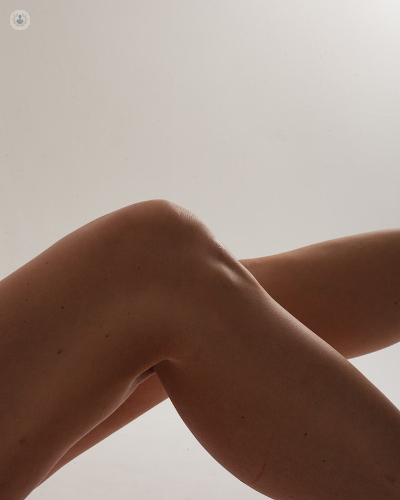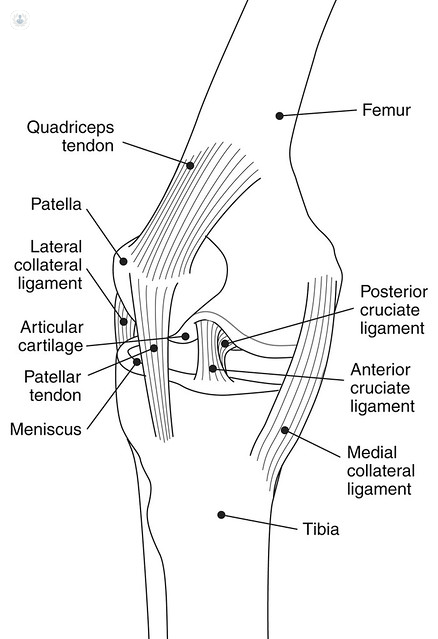The ultimate guide to knee pain
Written by:Many of us get knee pain from time to time, but it can be difficult to know whether it’s a problem that will fix itself or something that needs treatment. Here is a complete guide to the causes of knee pain and how to treat it by expert orthopaedic surgeon Professor Ali Ghoz.

How the knee works
The knee is one of the most important joints in your body. It includes bones such as the femur, patella, kneecap and the tibia, as well as soft tissues - ligaments and cartilage – which hold the bones and muscles together and help the knee to move.
Looking at the diagram below you can see four ligaments:
- the collateral ligaments which surround the knee on either side – the medial collateral and the lateral collateral ligament
- the cruciate ligaments on the inside of the knee – the anterior cruciate and the posterior cruciate ligament

All of these ligaments have to function in synergy to preserve function of the knee and to allow us to play sports. The other structure that is important is the meniscus (cartilage) which acts as a cushions to the knee when you run or walk on them.
Types of knee pain
The common causes of knee joint pain can be divided into mainly two groups:
- acute injuries
- wear and tear
Acute injuries can affect any part of your knee and happen suddenly, causing acute knee pain. A ligament or the meniscus can tear and cause mechanical problems and pain in the knee. The bones in your knee can fracture due to traumatic injuries such as falls, car accidents, or even through simple twisting while you're walking down the road, for example.
Wear and tear injuries happen over time and can cause chronic knee pain. One type of wear and tear injury is arthritis, where the cartilage becomes thinner to the point where there is no space between the two surfaces of bone in your knee – eventually eroding the bone itself. Other wear and tear injuries are associated with certain sports – such as runner’s knee – or certain occupations that involve a lot of kneeling, such as carpentry or gardening.
Overall, knee pain causes are varied, and you should pay close attention to your symptoms. Is the knee pain constant, or did you get sudden and severe knee pain? Does it involve other symptoms such as swelling, clicking, or instability? Is the pain on the outside, from the hip to the knee, or in the inner knee?
Knee pain relief at home
Start by resting the knee. Stop activities as much as possible to try and allow the knee to recover and give it room to breathe.
If the knee is swollen, use ice to reduce the swelling , especially after an injury while playing football or rugby. Using an ice pack at home can help reduce pain and swelling at the same time. Sometimes we use what we call a compression bandage to compress the knee and reduce the swelling as well.
Elevate the knee on a stool or a couple of pillows to relieve swelling as well as helping to reduce pain.
Taking simple painkillers helps relieve the pain as well and reduce the inflammation. This can include paracetamol or anti-inflammatories such as ibuprofen if you're allowed to take it.
Avoid the activities that might trigger the onset of pain. For example, if the pain gets worse while squatting or doing lunges, then you may want to avoid those certain movements. If you find going down the stairs can be a little tricky, go one step at a time. Above all, avoid any activities where you might need to do a sudden change of direction on the knee and try and do linear exercises.
It's important to start physiotherapy whenever you're able to do so. Physiotherapy helps to strengthen the muscles and the envelope around the knee to try and provide strength to the knee to be able to cope with stresses.
Wearing the right shoe wear is very important especially if you run quite a lot. Get a fitted running shoe to allow you to run if you do a lot of running.
Sometimes, taping can help reduce some of the swelling or pain around the knee. This can include the use of patellar taping, or stretching the tendons using either dynamic or static taping. You might have seen this on football players – the blue tape or black tape which is also used on the shoulders as well as the knee.
When to seek medical advice
You need to seek medical advice when:
- you have a problem with your knee that is not getting better
- you notice that your walking distance is decreasing
- you have problems going up inclines or going down hills
- you have problems with going up or down the stairs
- your knee is starting to give way regularly and is not holding your weight
- the patella or the kneecap is dislocated and moving sideways more than normal
- you’re experiencing painful clicking
- you’re experiencing general reduced mobility
- you have pain at rest or pain at night.
These are all symptoms that could delineate that there is a problem which could be either due to either an injury such as an acute injury or a chronic injury which has become worse overtime.
How knee pain is treated
Knee pain is treated by conservative options and surgical options.
Conservative options
The first form of treatment is easily done at home and is what we call the RICE regime: rest, ice, compression, and elevation.
This is followed by painkillers which include paracetamol and anti-inflammatories. These reduce the inflammation and reduce the swelling and also help to control pain symptoms.
Next, we have injections. Injections are especially helpful if the underlying pathology is wear and tear. There are various types of injections:
- traditional injections are most common and local anaesthetic and steroid injections to reduce inflammation
- newer injections have varying levels of evidence and include platelet-rich plasma or PRP. In certain pathologies PRP can help, such as patellar tendinopathy or quadriceps tendinopathy which is where there is inflammation of the tendons around the knee. There is some evidence that it might help in arthritis as well.
The knee might need further imaging such as X-ray or an MRI scan if the pain is sharp and intermittent and it's associated with mechanical symptoms – such as the knee giving way, collapsing on you, or instability.
If the scans show tendon or muscle injuries, these will get better stretching the muscles and ensuring you give yourself plenty of rest.
However, if the scans show ligament or cartilage tears, such as an ACL tear or meniscus tear, these do not get better on their own, and may require surgery.
Surgical treatment
There are several injuries that may need surgical treatment:
Cartilage or ligament tears – these may require surgery in the form of arthroscopic or keyhole (minimally-invasive) surgery to repair the damaged tissue.
Severe arthritis – this can cause pain at rest or pain at night, and significantly reduce your tolerance to exercise. For this type of problem, surgery is usually recommended in the form of either a partial or a total knee replacement.
If you have a knee replacement in this day and age, the chances of it surviving for 20 to 25 years are eight out of ten - which is a good statistic to have.
If you are concerned about recurrent knee pain and wish to schedule a consultation with Professor Ghoz, you can do so by visiting his Top Doctors profile.


